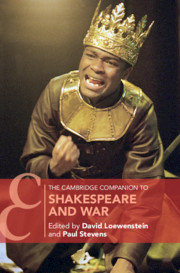Book contents
- The Cambridge Companion to Shakespeare and War
- The Cambridge Companion to Shakespeare and War
- Copyright page
- Dedication
- Contents
- Figures
- Contributors
- Preface
- Acknowledgments
- 1 Beyond Shallow and Silence
- 2 Just War Theory and Shakespeare
- 3 Shakespeare on Civil and Dynastic Wars
- 4 Foreign War
- 5 War and the Classical World
- 6 “The Question of These Wars”
- 7 Instrumentalizing Anger
- 8 War and Eros
- 9 Shakespeare’s Language and the Rhetoric of War
- 10 Staging Shakespeare’s Wars in the Twentieth and Twenty-First Centuries
- 11 Reading Shakespeare’s Wars on Film
- 12 Shakespeare and World War II
- 13 Henry V and the Pleasures of War
- 14 Macbeth and Trauma
- 15 Coriolanus and the Use of Power
- Index
- References
11 - Reading Shakespeare’s Wars on Film
Ideology and Montage
Published online by Cambridge University Press: 17 August 2021
- The Cambridge Companion to Shakespeare and War
- The Cambridge Companion to Shakespeare and War
- Copyright page
- Dedication
- Contents
- Figures
- Contributors
- Preface
- Acknowledgments
- 1 Beyond Shallow and Silence
- 2 Just War Theory and Shakespeare
- 3 Shakespeare on Civil and Dynastic Wars
- 4 Foreign War
- 5 War and the Classical World
- 6 “The Question of These Wars”
- 7 Instrumentalizing Anger
- 8 War and Eros
- 9 Shakespeare’s Language and the Rhetoric of War
- 10 Staging Shakespeare’s Wars in the Twentieth and Twenty-First Centuries
- 11 Reading Shakespeare’s Wars on Film
- 12 Shakespeare and World War II
- 13 Henry V and the Pleasures of War
- 14 Macbeth and Trauma
- 15 Coriolanus and the Use of Power
- Index
- References
Summary
This chapter considers how, in six successful Shakespeare films, exclusively cinematic formal methods of depicting battle serve to interpret and transform the plays’ perspectives on warfare. Special emphasis is placed on the concept (and deployment) of dialectical montage first developed by Sergei Eisenstein in his seminal 1929 essay, “The Dramaturgy of Film Form.” Though Eisenstein’s relatively rigid theory of montage has been endlessly appropriated, expanded and, at times, openly rejected by filmmakers and scholars alike, it remains ground zero for realist cinematic treatments of warfare and a key of sorts for deciphering individual filmmakers’ ideological orientations to their subject matter. The chapter argues that even the least overtly political film adaptations of Shakespeare’s plays tend to reveal a certain preoccupation with the ethical, ideological, and, of course, hermeneutic implications of representing battle scenes in a medium that all but demands their representation.
Keywords
- Type
- Chapter
- Information
- The Cambridge Companion to Shakespeare and War , pp. 187 - 204Publisher: Cambridge University PressPrint publication year: 2021



